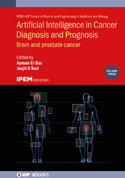Artificial Intelligence in Cancer Diagnosis and Prognosis, Volume 3
Editorial: IOP
Licencia: Creative Commons (by-nc)
Autor(es): Jasjit S Suri
The book covers the state-of-the-art artificial intelligence techniques used to
diagnose brain and prostate cancer, focusing on non-invasive approaches. Cancer
is the leading cause of death worldwide, regardless of the type of malignancy. As
recently as 2020, about ten million people died due to cancer worldwide. The early
detection of cancer tremendously increases the patient’s chances of survival.
Unfortunately, most cancer patients are diagnosed in the final stages of the disease.
Recently, artificial intelligence and deep learning have been shown to offer
significant potential to solve this issue. This volume of the book will focus on the
use of artificial intelligence techniques for the early diagnosis of brain and prostate
cancer. Prostate cancer is the most common cancer in men in the United States (after
skin cancer). It is the second leading cause of death in men in the United States.
Different types of tumor can exist in the brain. These tumors can be benign or
malignant and can significantly affect the nervous system, depending on their
location and growth rate. Among the topics discussed in the book are the use of
artificial intelligence in prostate cancer treatment in conjunction with imagingguided radiation therapy; artificial-intelligence-based diagnosis of brain tumor
diseases; multisite brain tumor segmentation using unified generative adversarial
networks; automatic segmentation of brain metastases for radiotherapy; the
classification of hyperspectral in vivo brain tissue; bone cancer metastasis classification in prostate patients; prostate cancer detection using histopathology image
analysis; and machine learning of gliomas in 3D dynamic contrast-enhanced MRI.
In summary, the main aim of this book is to help advance scientific research
within the broad field of the early detection of brain and prostate cancer. This book
focuses on major trends and challenges in this area, and it presents work that aims to
identify new techniques and their use in biomedical analysis.
Compartir:
Una vez que el usuario haya visto al menos un documento, este fragmento será visible.


